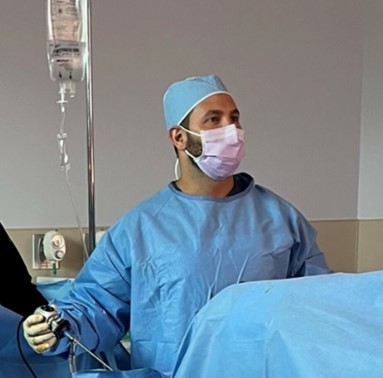Georges Akl M.D.
Dr. Georges Akl is the Founder and Chairman of the Gynecology Department at the Omni Surgery Center in Utica, NY. Georges Akl M.D. treats women with an array of medical and surgical conditions, ranging from routine women's health exams and pregnancy to more complicated conditions such as cervical dysplasia, uterine fibroids, infertility, pelvic organ prolapse, and many others. In the following article, Dr. Georges Akl unravels the mysteries surrounding endometriosis, providing valuable insights for those affected and the medical community alike.
Data provided by the World Health Organization highlights endometriosis, a chronic disease associated with life-impacting period pains, bowel movements/urination, sexual intercourse, abdominal bloating, and more, which affects approximately 10% or 190 million women and girls around the world. While there's currently no known cure, treatment options are available to manage symptoms.
Starting as early as a woman's first menstruation cycle and lasting until menopause, the chronic condition can be debilitating for many diagnosed individuals. Dr. Georges Akl notes better understandings of the disease, its symptoms, causes, and treatments to give such people the knowledge they need to control the pain to lead a happier life.
Georges Akl M.D. on Understanding Endometriosis and Its Symptoms
Characterized by tissue akin to the uterus' lining growing outside the uterus, endometriosis often causes severe pain and fertility. As the tissue develops, inflammation and scar tissue (e.g., adhesions, fibrosis) form across the pelvic region, sometimes making its way around other areas of the body.
Georges Akl M.D. says that while endometriosis-resultant lesions outside the pelvic region are rare, he mentions those found within the pelvic region include:
- Cystic ovarian endometriosis (a.k.a., endometrioma) in the ovaries;
- Superficial endometriosis on the pelvic peritoneum; and
- Deep endometriosis in the recto-vaginal septum, bowel, and bladder.
Interestingly, not every woman with endometriosis experiences symptoms. Georges Akl M.D. explains that those who do, however, tend to have pain in their pelvis that's most noticeable in the following scenarios:
- During or after sex
- Throughout a period
- When urinating
- When defecating
Other symptoms include:
- Heavy bleeding (during or between periods)
- Difficult conceiving
- Chronic pelvic paiN
- Depression
- Anxiety
- Fatigue
- Bloating
- Nausea
Healthcare practitioners understand the disease's symptoms are extremely varied and wide-reaching. In truth, they can be as diverse as the people who it affects. Thus, doctors and specialists often find it difficult to diagnose.
Breaking Down the Causes of Endometriosis
Georges Akl M.D. explains that endometriosis' complexity makes it tricky for practitioners to determine steadfast causes. Currently, researchers are studying five factors that may cause the disease:
- Hormones Estrogen has been shown to promote endometriosis. Present research suggests the disease could occur due to a problem with a person's hormone makeup.
- Retrograde menstruation Considered the most likely cause of endometriosis, retrograde menstruation is when menstrual blood holding endometrial cells travels through the fallopian tubes and into the pelvic cavity while the blood is flowing out the body during periods, depositing endometrial cells outside the uterus. Once landed, such cells can implant and develop, triggering the disease.
- Genetics Some families have a history of endometriosis, leading to researchers dubbing genetics as a cause.
- Immune system problems Faulty immune systems might fail to destroy endometrial tissue found outside the uterus. Certain cancers and other immune system disorders are more prevalent in people with the disease.
- Cesareans C-sections, hysterectomies, and other surgery to the abdominal region can cause accidental movement of endometrial tissue, causing the condition.
 Treating Endometriosis: From Lifestyle Alterations to Surgical Interventions
Treating Endometriosis: From Lifestyle Alterations to Surgical Interventions
Those diagnosed with endometriosis will undoubtably find it difficult to discover there's presently no cure. However, Georges Akl M.D. explains that they aren't without options; treatments for controlling symptoms exist, ranging from somewhat simple lifestyle changes to more invasive surgical procedures.
Individuals should always consult their doctor(s) when deciding which treatment(s) to try as they aren't all suitable for every person. Dr. Georges Akl reports that the following serves as an overview to the wide variety available.
Lifestyle Changes
Usually, the first port of call for doctors treating endometriosis patients, lifestyle changes aren't invasive and necessitate the patient switching up routines to determine whether it eases their pain. Practitioners may suggest:
- Eating more fruits, vegetables, and fish
- Abolishing alcohol
- Getting more exercise
- Using hot water bottles
- Practicing mindfulness
- Acupuncture
- Avoiding coffee
- Acquiring emotional support
Pain Relief and Hormone Therapy
Dr. Georges Akl notes that the suggested pain relief methods usually involve over-the-counter medicines, such as Advil, Motrin IB, and Aleve. Since this alone may not be enough to soothe the pain, they typically combine it with hormone therapy like progestin, hormonal contraceptives, aromatase inhibitors, and
Gn-RH agonists and antagonists.
Surgery
Dr. Georges Akl says that when the above isn't enough, practitioners suggest conservative surgery to remove endometriosis tissue. Those who're trying to become pregnant often choose this option to improve their success with fertility. Often a laparoscopic surgery, it removes thick scar tissue, relieving chronic pain and bleeding complications.
Hysterectomies and ovary removals are still conducted to treat endometriosis. However, it's no longer considered the most effective treatment just a last resort.
Conclusion
In conclusion, Dr. Georges Akl's comprehensive insight into endometriosis offers valuable knowledge for those affected by this chronic condition. With approximately 10% of women worldwide experiencing its impact, understanding the symptoms, causes, and available treatment options becomes paramount. From lifestyle adjustments to surgical interventions, individuals have a range of strategies at their disposal. Consulting with a healthcare provider is crucial to determine the most effective approach. While there may be no outright cure, the array of treatments available can significantly improve the quality of life for those dealing with endometriosis. With ongoing research and advancements in medical understanding, there is hope for continued progress in managing this complex condition.
 Treating Endometriosis: From Lifestyle Alterations to Surgical Interventions
Treating Endometriosis: From Lifestyle Alterations to Surgical Interventions